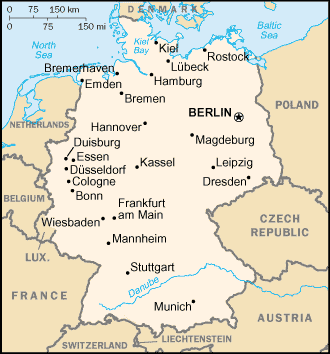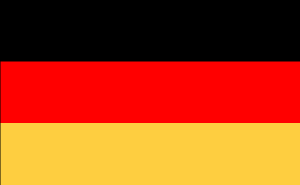
|
Germany
Background:
As Europe's largest economy and most populous nation, Germany remains a key
member of the continent's economic, political, and defense organizations.
European power struggles immersed the country in two devastating World Wars in
the first half of the 20th century and left the country occupied by the
victorious Allied powers of the US, UK, France, and the Soviet Union in 1945.
The decline of the USSR and the end of the Cold War allowed
for German unification in 1990.
Location:
Central Europe, bordering the Baltic Sea and the North Sea, between
the Netherlands and Poland, south of Denmark.
Area: Total: 357,021 sq km, water: 7,798 sq km. land: 349,223 sq km.
Area - comparative: Slightly smaller than Montana.
Land boundaries: Total: 3,621 km, border countries: Austria 784 km, Belgium 167
km, Czech Republic 646 km, Denmark 68 km, France 451 km, Luxembourg 138 km,
Netherlands 577 km, Poland 456 km, Switzerland 334 km.
Coastline: 2,389 km.
Climate and Terrain:
Climate: Temperate and marine; cool, cloudy, wet winters and summers;
occasional warm foehn wind .
Terrain: Lowlands in north, uplands in center, Bavarian Alps in south.
Natural resources: Iron ore, coal, potash, timber, lignite, uranium, copper,
natural gas, salt, nickel, arable land.
People:
Population: 83,251,851.
Ethnic groups: German 91.5%, Turkish 2.4%, other 6.1% (made up largely of
Serbo-Croatian, Italian, Russian, Greek, Polish, Spanish).
Religions: Protestant 34%, Roman Catholic 34%, Muslim 3.7%, unaffiliated or
other 28.3%.
Languages: German.
Government:
Government type: Federal republic.
Capital: Berlin.
Independence: 18 January 1871 (German Empire unification).
Economy overview:
Germany's affluent and technologically powerful economy turned in a relatively
weak performance throughout much of the 1990s. The modernization and
integration of the eastern German economy continues to be a costly long-term
problem, with annual transfers from west to east amounting to roughly $70
billion. Germany's ageing population, combined with high unemployment, has
pushed social security outlays to a level exceeding contributions from workers.
Structural rigidities in the labor market - including strict regulations on
laying off workers and the setting of wages on a national basis - have made
unemployment a chronic problem.
GDP - composition by sector: Agriculture: 1%, industry: 28%, services: 71%.
Statistics:
Telephones - main lines in use: 50.9 million.
Telephones - mobile cellular: 55.3 million.
Radio broadcast stations: AM 51, FM 787, shortwave 4.
Radios: 77.8 million.
Television broadcast stations: 373 (plus 8,042 repeaters).
Televisions: 51.4 million.
Internet users: 28.64 million.
Railways: Total: 44,000 km.
Highways: Total: 656,140 km, paved: 650,891 km, unpaved: 5,249 km.
Airports: 625, with paved runways: 325, with unpaved runways: 300.
Heliports: 59.
Return to Visiting Locations
|

